Parents and students are searching for tutors online, so if your website isn’t ranking, they’re finding your competitors instead. In the education industry, organic search is a major driver of leads, yet many tutoring services fail to capitalize on it. But smart SEO optimization can change that.
Every business aspires to grow organic traffic, enhance search engine rankings, and boost conversions. In this case study, we will guide you through our step-by-step process that helped a tutoring service website reach these objectives with an effective SEO strategy.
Our approach began with a comprehensive site audit, which served as the foundation of our work. Based on these insights, we implemented technical optimizations, content improvements, link-building campaigns, and on-page SEO enhancements.
Moreover, our SEO strategy was continuously adjusted based on performance data and the client’s evolving needs. This adaptive plan allowed us to increase organic traffic by 28% — and it’s still growing — while securing top rankings for key search queries during peak seasons.
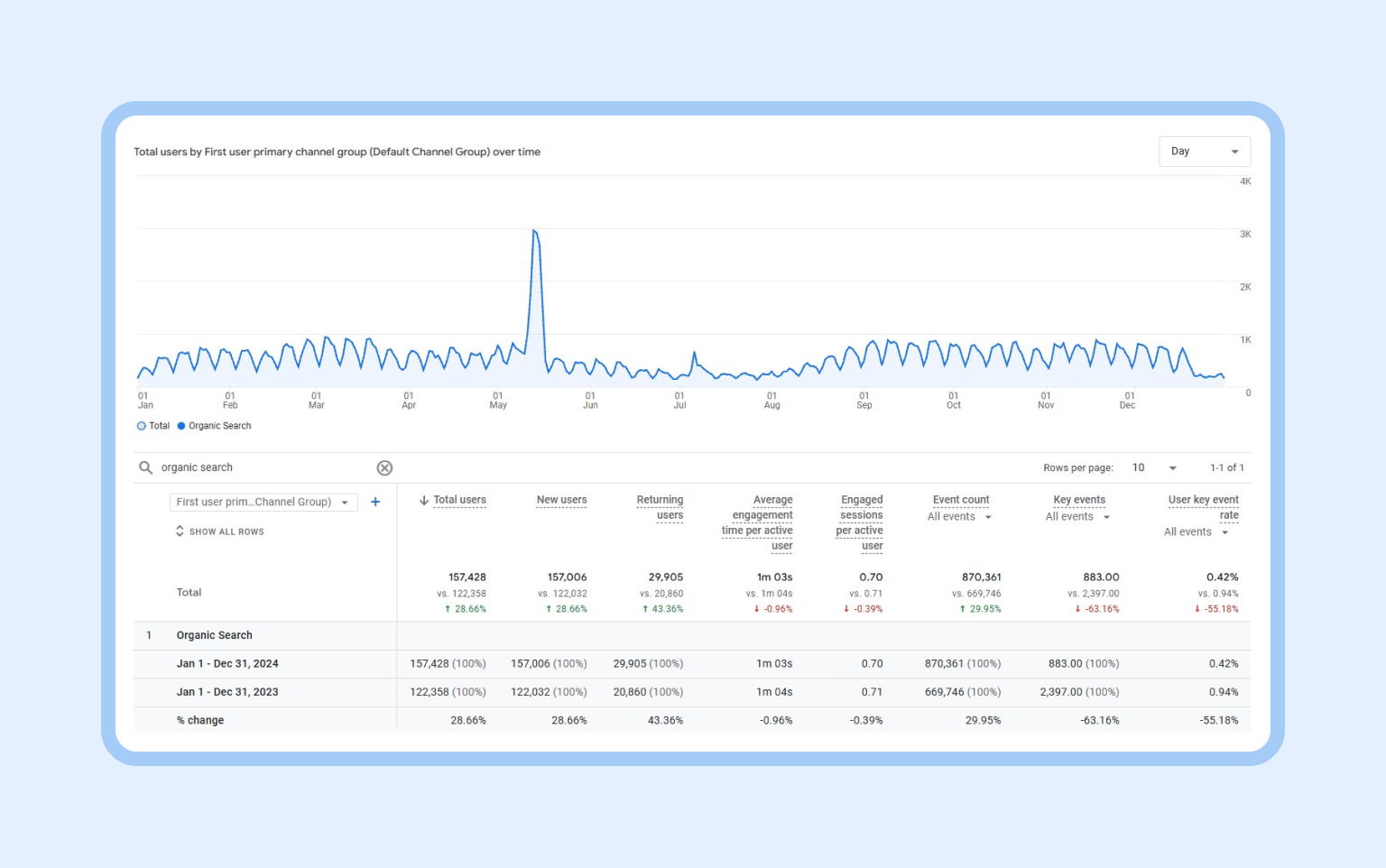
So, let’s explore in detail how we made it happen!
Project kickoff and SEO audit alignment
Our first step was to clearly outline the key objectives and align the action plan with the client. This helped establish a well-structured project roadmap, ensuring efficient resource allocation and realistic timelines for execution.
The SEO audit plan covered multiple critical areas, including:
1. Current website performance analysis.
- Analysis of existing keywords, traffic trends, and search rankings;
- Assessment of regional targeting and device-based traffic distribution;
- Identification and analysis of main competitors.
2. Recommendations for improving website pages.
- Enhancements to the site structure, including suggestions for adding important new pages;
- Optimizations for different page types: homepage, listing pages, blog pages;
- Recommendations for E-A-T (Expertise, Authoritativeness, and Trustworthiness) factors to improve search rankings;
- Specific guidance on content creation and blog development.
3. Technical SEO audit.
- Identification and prioritization of technical issues;
- Detailed recommendations for fixing errors.
4. Backlink profile audit.
- Analysis of the website’s existing backlink profile;
- Competitive backlink analysis;
- Recommendations for future link-building efforts.
Additionally, the audit provided insights and recommendations not only for the current version of the website but also for its upcoming redesigned version. This helped us to ensure a smooth transition and continued SEO growth.
SEO audit
As previously stated, our primary goal was to analyze the website’s performance and identify opportunities to improve its rankings and traffic in Google’s search results. Below, we will discuss each stage of the audit in detail and what we learned from them.
Current website performance analysis
We conducted a thorough assessment of the website’s current state to identify any existing traffic issues. Special attention was given to the devices most commonly used by visitors from Google search, allowing us to determine the site’s priority version for further analysis.
In addition, we examined regional traffic distribution and keyword performance to pinpoint the main competitors. Based on both the client’s input and Google SERP data, we selected the key websites and analyzed their traffic using Ahrefs. We discovered that, in addition to service pages, competitors were generating significant traffic through informational sections.
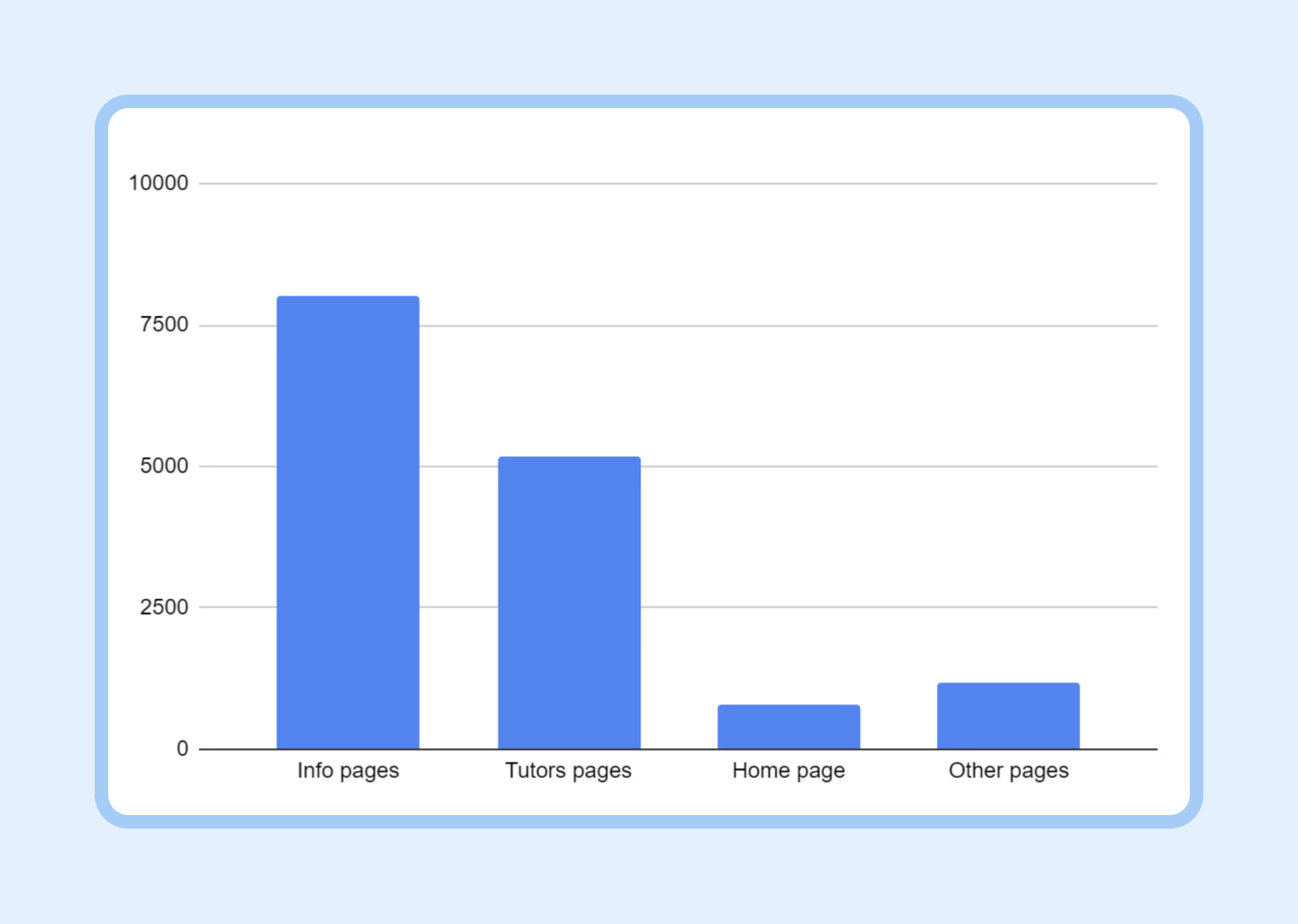
We also analyzed the typical site structures of competitors. Later, it helped us provide recommendations for improving the structure and internal linking of the client’s website.
Furthermore, the competitor analysis played a key role in identifying the main strategic directions for future work and shaping the initial action plan. We’ll go through all that more closely in the next few sections.
<div class="post__style-link">To learn more about conducting an in-depth competitor analysis, check out our guide, How to do an SEO competitor analysis.</div>
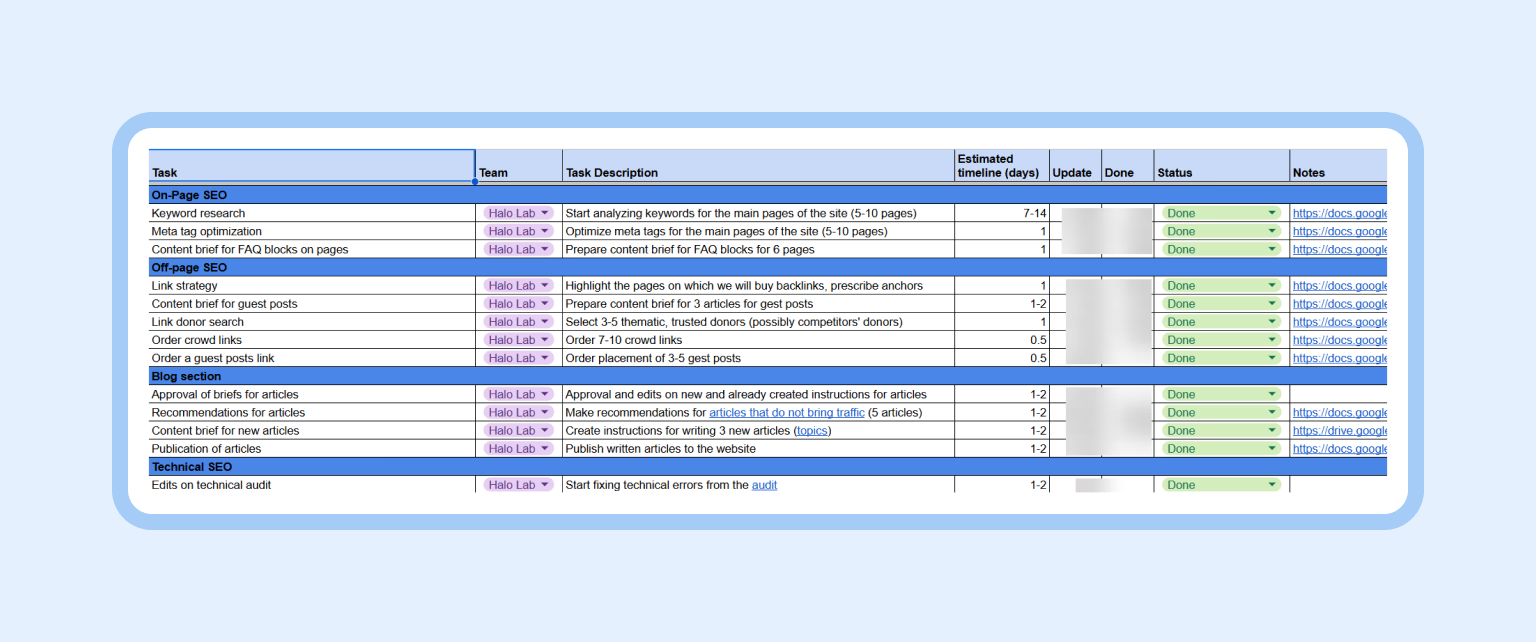
Recommendations for improving website pages
After conducting an in-depth analysis of both competitors and the client’s website, we moved on to formulating recommendations for improving the site’s performance. These were categorized into distinct groups:
- Enhancements for specific page types: homepage, listing pages, and blog pages;
- Improvements to site structure and the addition of important new pages;
- E-A-T ranking factors optimization;
- Guidelines for further blog development.
We began by developing recommendations to optimize the existing pages. For instance, our analysis of the homepage revealed that several crucial elements were missing from an SEO perspective. To address these gaps and improve the homepage design, we recommended adding the following blocks and elements:
- Internal linking section with links to the main website categories;
- Tutor profile links;
- “How It Works” section;
- Call-to-action (CTA) form with an option for direct inquiries or feedback.
These additions were aimed at not only improving textual relevance but also enhancing internal linking, which positively impacted navigation, indexing, and overall traffic growth.
During our analysis of the main category pages, we identified several shortcomings that negatively impacted the website’s search rankings. Specifically, these pages lacked essential commercial elements, text blocks, and internal linking structures. To address these issues, our recommendations focused on the following:
1. Expanding listing functionality:
- visual redesign of listing pages, ensuring that tutors for specific subjects are prominently displayed within relevant category pages;
- addition of links to tutor profile pages;
- enhancement of tutor preview cards by including key details such as specialization, teaching experience, ratings, etc;
- addition of filtering functionality to improve overall usability.

2. Optimizing category pages:
- addition of a text block to improve the on-page text optimization;
- integration of a reviews section to strengthen E-A-T factors;
- enhancement of internal linking by incorporating site-wide blocks with links to other related pages within the same category.
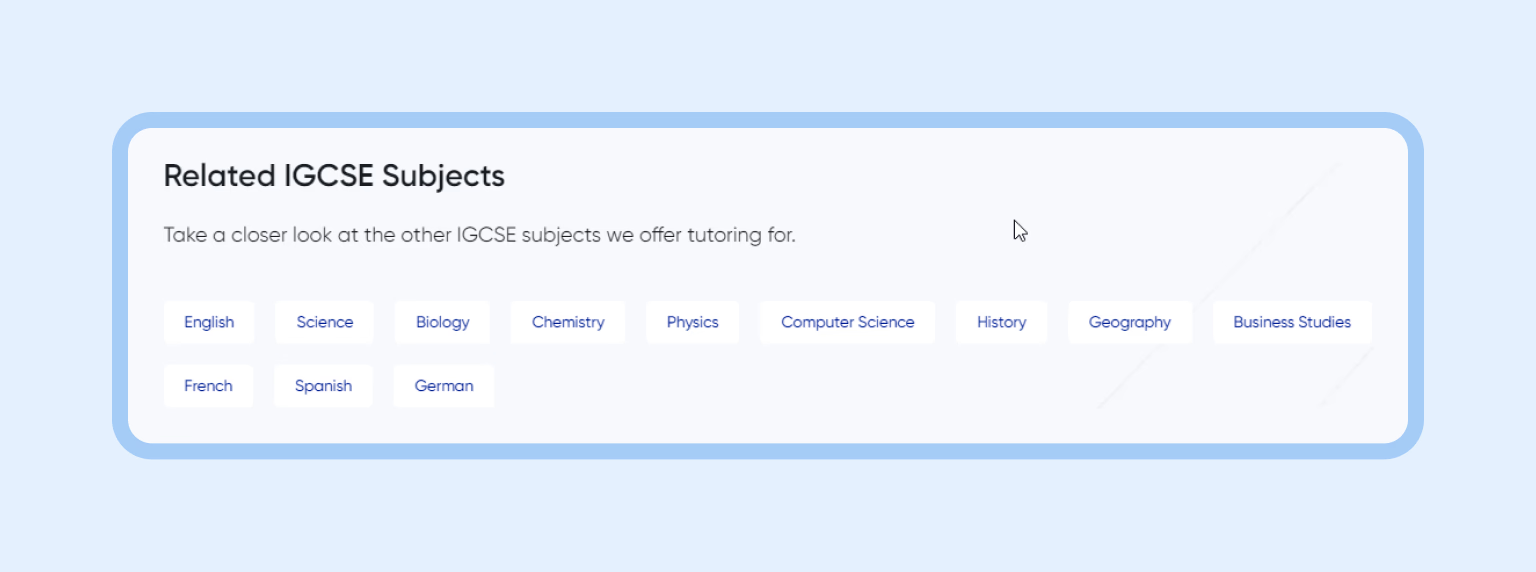
Optimizing category pages following this strategy positively impacts both attracting new traffic and improving user interaction with the website.
Additionally, we focused on recommendations for creating a dedicated section for all tutors and individual tutor profile pages. Our competitor analysis revealed that every major player in the niche had these types of pages, whereas our client’s website lacked them. This was a critical gap, as such pages play a significant role in the competitor’s site structure and offer these benefits:
- Attract additional organic traffic;
- Serve as a selection page where users can easily browse and choose a tutor;
- Signal to Google that the website offers a substantial selection of tutors, increasing its chances of ranking in top positions.
To leverage these advantages, we recommended developing a dedicated tutor directory section. This required creating a main page listing all tutors and individual tutor profile pages, which would reinforce the website’s expertise and positively impact its SEO performance.
Our recommendations also included optimizing the Contact Us page, the About Us page, and expert credentials to improve the E-A-T factors for ranking further. Additionally, we suggested incorporating international school awards, quality certifications, and other credibility indicators to strengthen the website’s trust signals.
As outlined above, many of our competitors have successfully generated traffic through their blog sections. To capitalize on this strategy, we provided the client with a structured approach to optimizing the informational section of the website. To do so, our team focused on two main areas:
1. Writing new articles:
- Outlined a process for selecting high-traffic topics;
- Provided detailed guidelines for creating content briefs for copywriters based on competitor analysis.
2. Optimizing underperforming articles.
This comprehensive approach would significantly increase informational traffic, which could be converted into commercial traffic and ultimately bring in real customers.
Technical SEO audit
As part of our comprehensive analysis, we conducted a separate review of the website’s technical condition to identify its weaknesses and errors. While we did not find any critical issues that could severely impact the site’s indexing and ranking, we compiled a list of recommendations for all detected errors. These were categorized based on priority levels:
- Priority 1. Errors that required immediate fixing. These were planned for resolution on the current version of the website.
- Priority 2. Issues that could be addressed later or implemented during the website redesign.
- Priority 3. Fixing these errors can be postponed. They had minimal impact on search rankings but were still advisable to avoid.
Among the key findings, we discovered that the site lacked a proper redirect setup from the x-www version to the primary non-www version. Additionally, some pages contained 404 broken links. We also identified redirect chains and ill-structured mobile page layouts, which could slow down loading times and reduce usability on mobile devices.
Another significant issue was incomplete or poorly optimized meta tags — including missing or improperly filled page titles and meta descriptions.
Lastly, a separate category of technical shortcomings was related to image optimization. We found oversized images that increased page load time and missing alt attributes.
As mentioned earlier, while none of these issues were critical, we began addressing them immediately as part of our broader website optimization strategy.
Backlink profile audit
Backlinks from external sources remain one of the most influential ranking factors in Google’s search algorithm. The more high-quality, authoritative, and relevant backlinks a website has, the more credibility and trust it gains in the eyes of search engines.
Upon analyzing the website’s backlink profile, we discovered that it was significantly underdeveloped. The site had very few quality backlinks and virtually no SEO-optimized anchor texts related to its niche. To address this issue, we conducted a competitor backlink analysis, which helped us formulate an effective link-building strategy and identify potential high-quality referring domains.
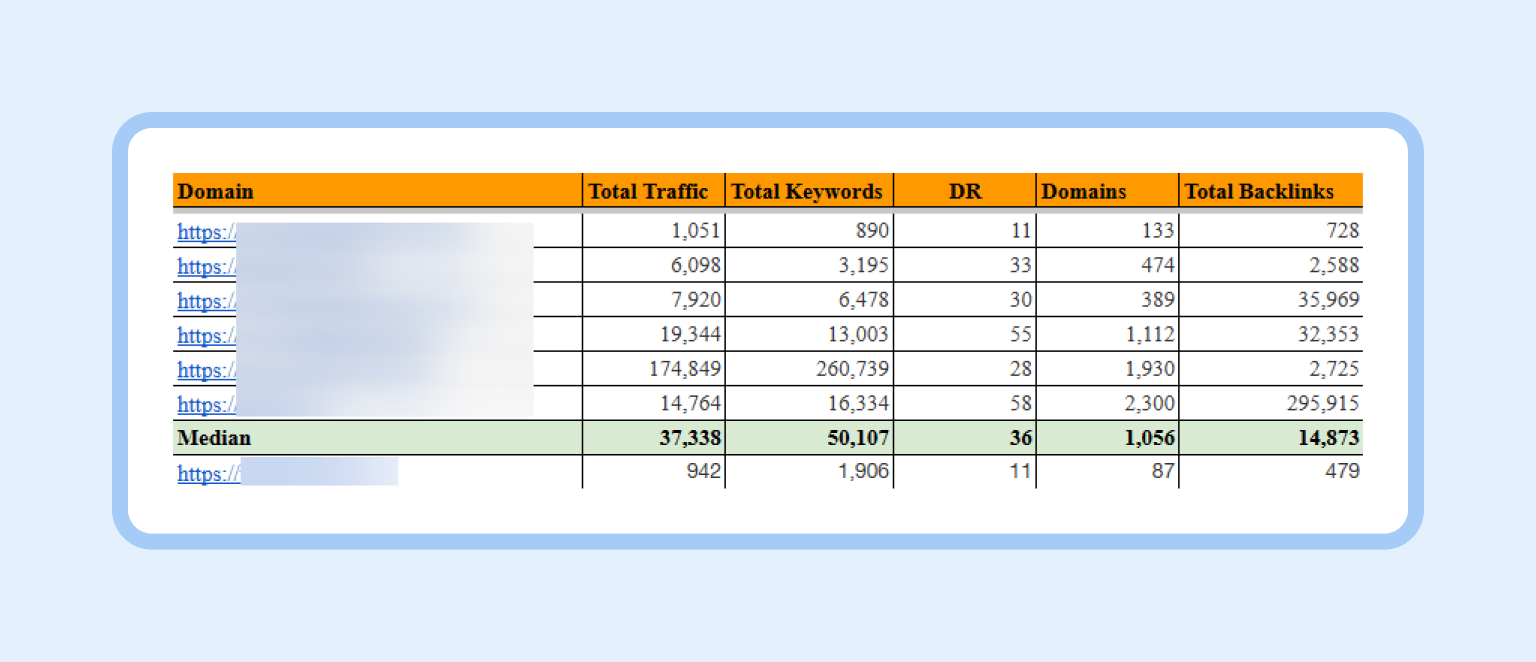
After initiating the optimization process, we followed our strategy by acquiring backlinks through guest posts (at least 5 links per month) and crowd links (approximately 7-10 links per month). This steady approach allowed us to organically grow the website’s backlink profile while avoiding any Google penalties.
In our recommendations, we specified suitable anchor texts for backlinks, outlined criteria for choosing high-quality link donors, and identified link types to avoid. Once the audit was complete, we proceeded to prepare a detailed action plan for optimizing the website’s pages.
Development of the optimization plan
When preparing the optimization plan, we had to take into account that the website would undergo future design and structural changes. Therefore, all tasks were divided into work for the current version of the site and work for its updated version. Let’s examine them below.
On-page optimization
Our primary focus was optimizing meta tags for category pages and improving existing on-page content, as we were unable to add new text blocks to the site at that stage. To achieve this, we conducted keyword research for each page and manually optimized H1 and H2 headings, title tags, and meta descriptions based on the collected semantic data.
Additionally, we enriched the existing text with relevant keywords that were missing at the start of our work. This foundational optimization made the pages more relevant to search queries from the outset.
Simultaneously, we prepared content briefs for a future FAQ section as part of the redesigned site structure. Our competitor analysis revealed that many of their pages featured template-based FAQ content — standardized question-and-answer blocks that either remained unchanged or had only minimal variations.
At first glance, using the same approach for our client’s website might have seemed reasonable. However, we chose a higher-quality content strategy, ensuring that each page featured unique, tailored text.
This approach gave us two advantages. First, it allowed us to enhance the textual relevance of the pages further. Second, based on our experience, we knew that without unique content, the site could face indexing issues, as the other page elements were quite similar across the website. Moreover, competitors might have secured strong rankings due to other factors, such as domain trust and backlinks, which our website lacked.
Work on the informational section
Following the recommendations from our SEO audit, we focused on two key areas:
- Optimizing existing articles that were not generating traffic for various reasons.
- Creating new articles to target relevant topics.
Our first step was to analyze competitors’ blog sections, identifying articles that were driving traffic to their websites. Based on this research, we selected topics that aligned with our strategy.
The analysis of competitors’ articles consisted of the following stages:
1. Analyzing article structure. We examined competitors’ headings, their number, and variety. To compare article structures effectively, we copied all heading levels into Google Sheets. From there, we grouped similar headings by meaning and used them to outline future article structure. Also, one could add unique sections that might not be present in every competitor’s article but could enhance the depth and informativeness of the content.
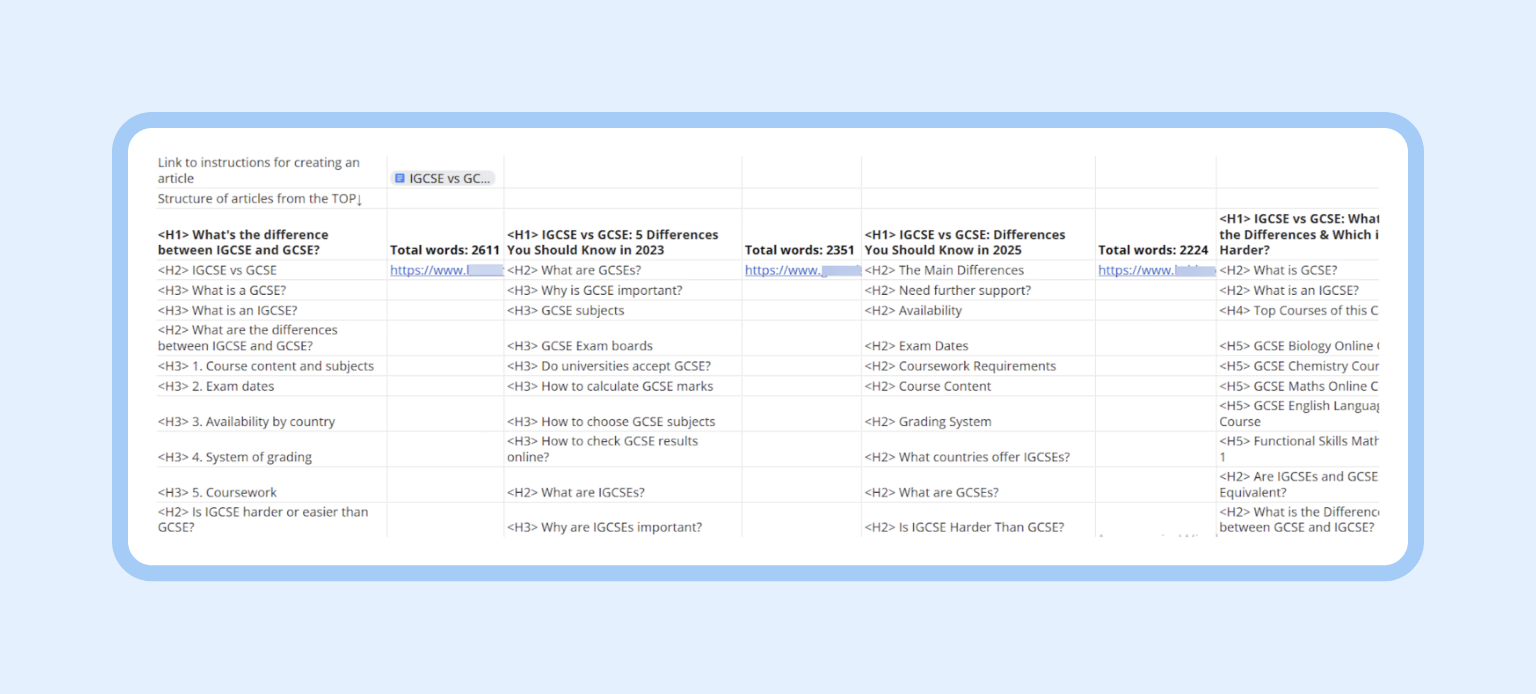
Headings could be collected manually by copying them individually or by using a browser extension like SEO META in 1 CLICK to extract all heading tags at once.
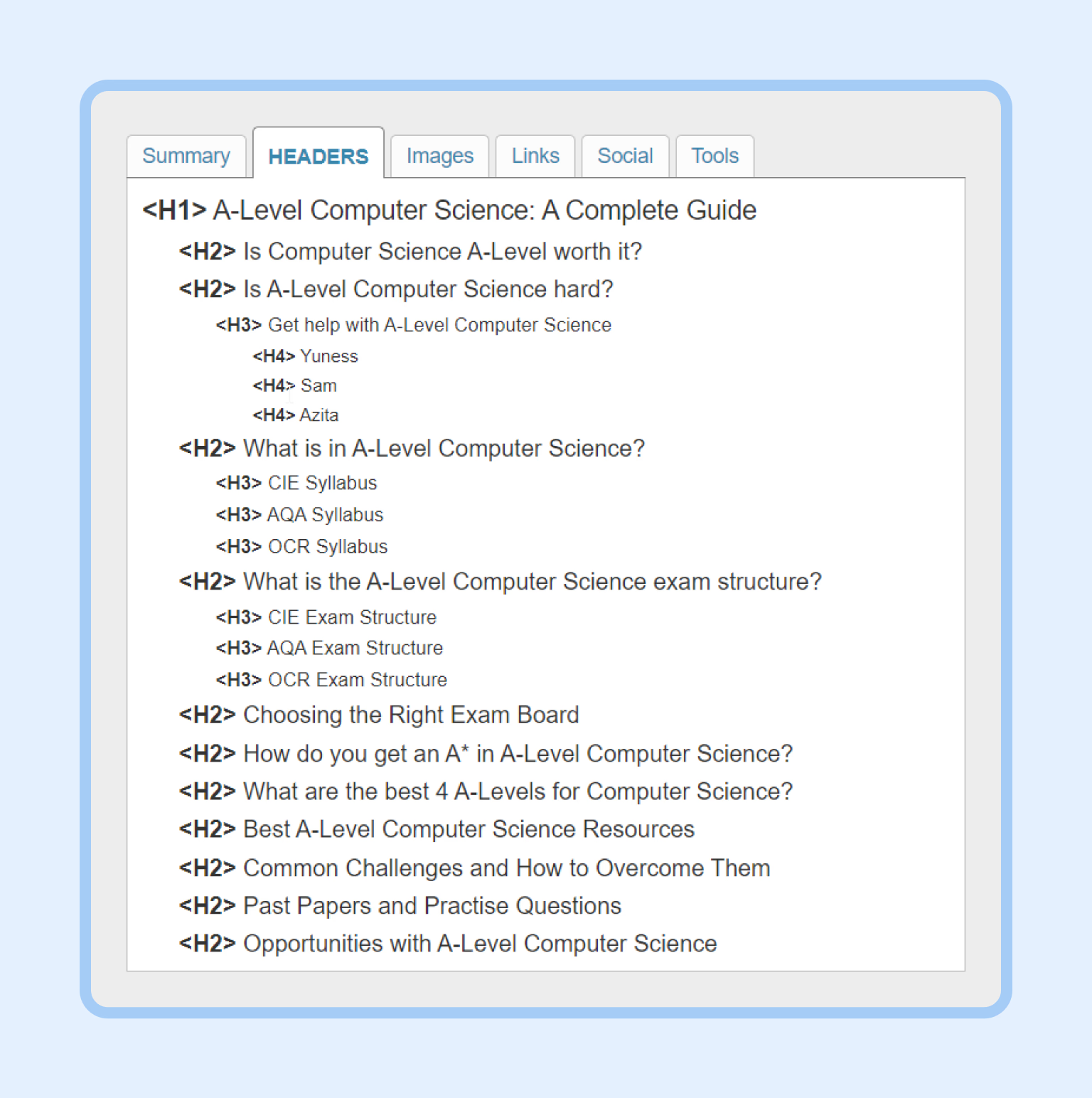
2. Analyzing article length. This can be done easily by just using standard text editors like Microsoft Word, Google Docs, TextEdit, or Notepad++. For instance, in Google Docs, you can check the word count by pasting the article into a document and then selecting Tools → Word count to view the total number of words.
Once we had thoroughly analyzed competitor articles, we moved on to preparing detailed content instructions for copywriters. Typically, these briefs include the following key elements:
- Article length (word count). The article should be neither shorter nor significantly longer than those ranking in the top search results for the target query.
- Article structure (headings). A clear outline with H1, H2, and H3 headings, depending on the complexity of the topic.
- Detailed descriptions for copywriters (if necessary). Certain sections may require additional instructions, including specific guidelines on content, tone, or key points to emphasize in particular paragraphs.
- List of main keywords. These are the most relevant target keywords for SEO, and their list should be concise to avoid over-optimization or keyword stuffing.
- List of additional keywords. Synonyms, related phrases, and topic-expanding terms that improve readability and enhance the article’s semantic richness.
- Competitor article examples. Sample articles that the copywriter can reference for style, depth, and content expectations while maintaining originality.
- Technical requirements. It includes uniqueness (content should be original and pass plagiarism checks), grammar and readability, visual elements (if applicable), and other aspects.
The process of optimizing articles that were not generating traffic followed a similar step-by-step approach:
- Analysis of the current article structure and its level of optimization (checking for the presence of all target keywords, optimized headings, title, and meta description).
- Competitor article analysis to identify strengths and best practices.
- Comparison and creation of a content revision brief for the copywriter. This involved expanding the article, updating the content, and adding optimized headings.
In addition, we included author information and publication dates in the blog section. This improved the quality of the content and made it more credible to Google.
Off-page optimization and technical fixes
Simultaneously, we began enhancing the website’s backlink profile. First, we pinpointed priority pages and chose suitable anchor texts for them. Then, we carefully selected link donors for backlink placements and started preparing content. The process of creating briefs for guest posts was similar to preparing blog article briefs, as our aim was to generate content that could be indexed and ranked for relevant keywords.
Plus, we began placing crowd links on reputable forums and in the comment sections of relevant articles. As for the key technical issues, our team addressed them in the very first month of work. Together with other optimization efforts, this helped enhance the overall quality and performance of the website.
Pause and strategy adjustment
Summer and winter holidays are periods of lowest demand for our client’s services. Across the entire niche, we observed a seasonal decline in traffic. As a result, we decided to take a pause during the first two summer and first two winter months to reassess and adjust our SEO strategy. Over this time, we:
- Analyzed the results achieved so far;
- Refined our strategy, focusing on selecting new article topics and enhancing our link-building efforts;
- Continued off-page optimization to maintain the growth of the backlink profile.
This approach proved to be effective. Our team maintained link-building efforts, and by the time core activities resumed, we had already gathered valuable insights and new content ideas to update our monthly task list.
Website promotion and initial results
The new website design is finished now, and its active development is underway. While all this is going on, our team is busy optimizing pages, writing blog articles, and keeping an eye on the website’s technical health. On top of that, we’re working on improving the backlink profile.
Within a year of work, we have built a high-quality backlink profile using niche-relevant resources. Our approach follows a gradual, non-aggressive strategy, steadily increasing the number of backlinks — and the results speak for themselves. In just a year, the website’s Domain Rating (DR) increased from 10 to 26, while the number of referring domains tripled.

Thanks to our efforts, we achieved peak traffic during the busiest fall season. Compared to the initial metrics, traffic increased by 28%!
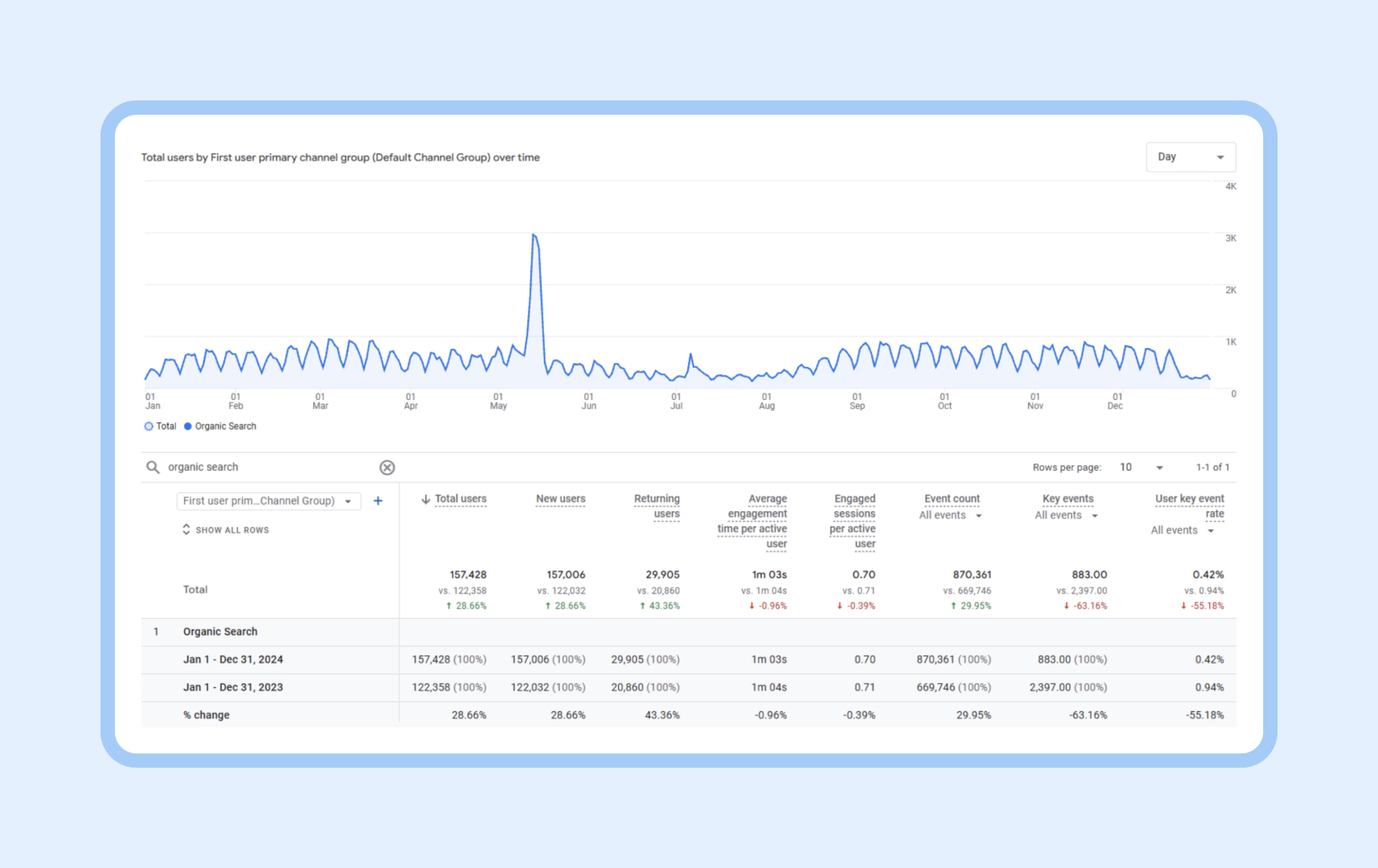
Traffic began to increase as we expanded the number of pages targeting core keywords, which enhanced visibility across additional keywords and resulted in higher traffic. We also saw growth thanks to better rankings for our main keywords.
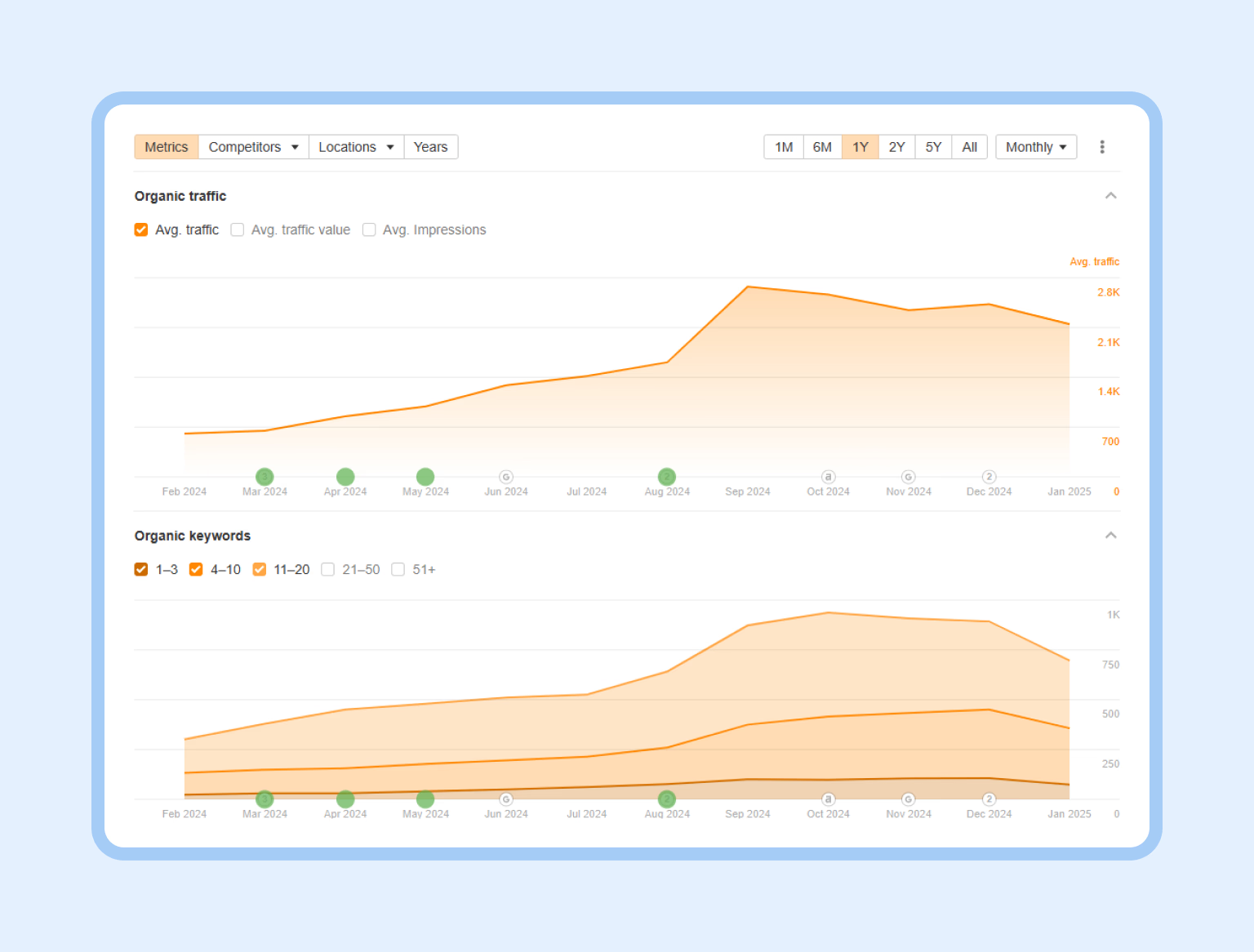
Currently, we are observing a seasonal traffic decline, but we continue working on improving page quality and overall performance. Over the past year, we have also seen ranking growth for priority keywords.
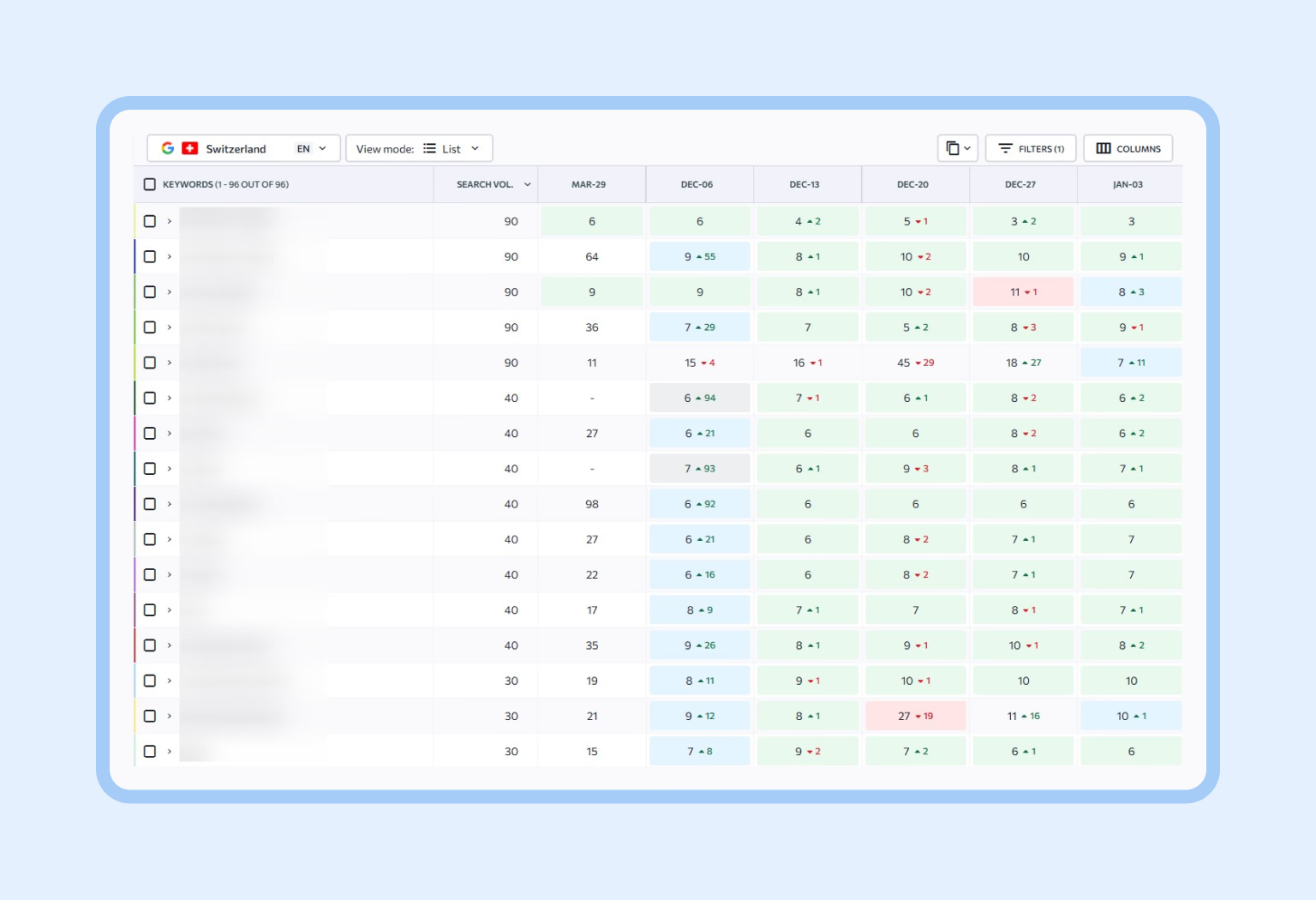
At the moment, 78% of all keywords rank in the top 10 positions on Google SERP, 46% hold the top 3 positions, and 31% rank first.
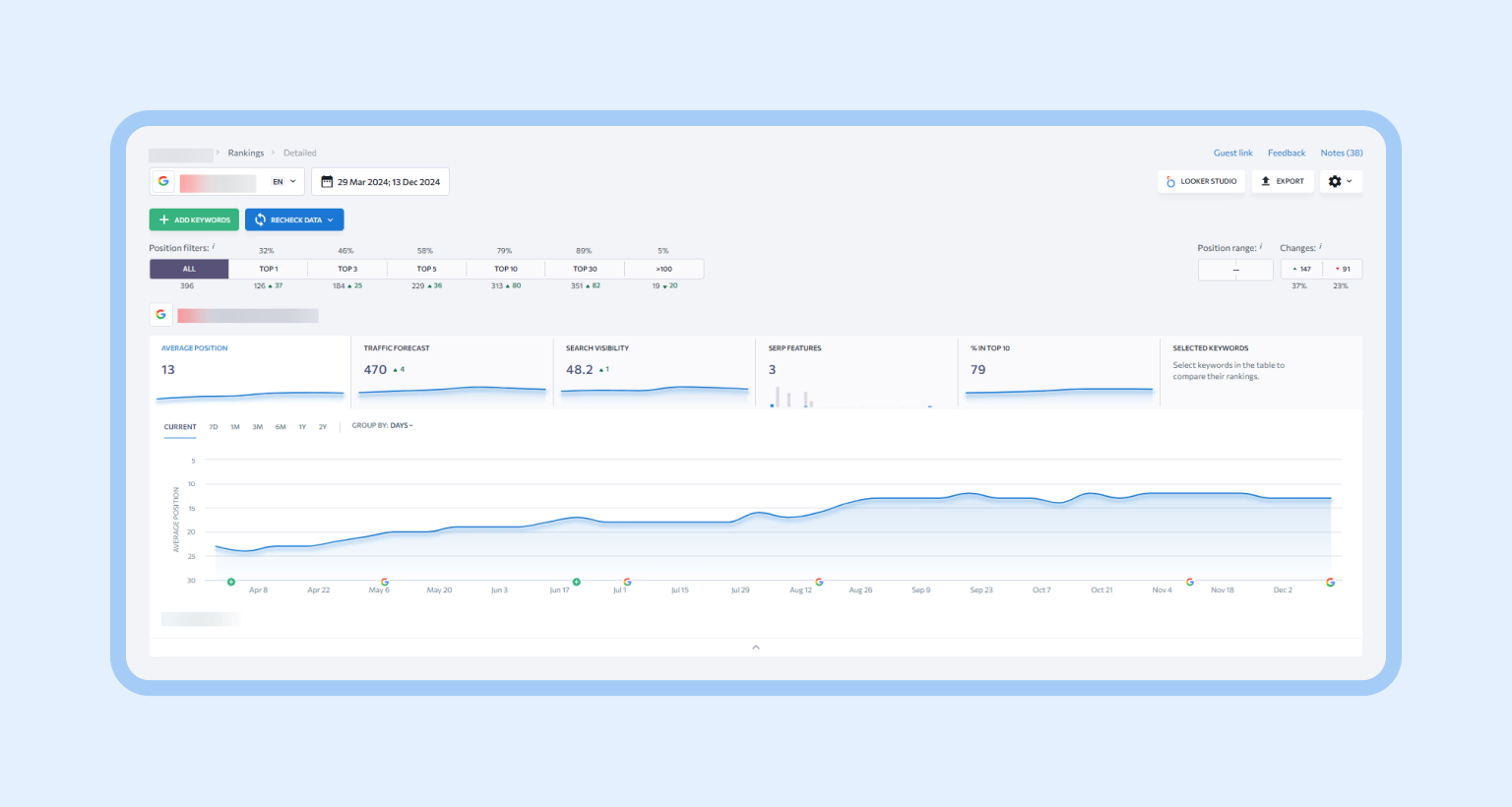
Some of the keywords didn’t rank on the site at all before — now they’re in the top 3. While not all of them are high-volume, low-volume keywords often bring higher conversion rates because users know exactly what they’re looking for.
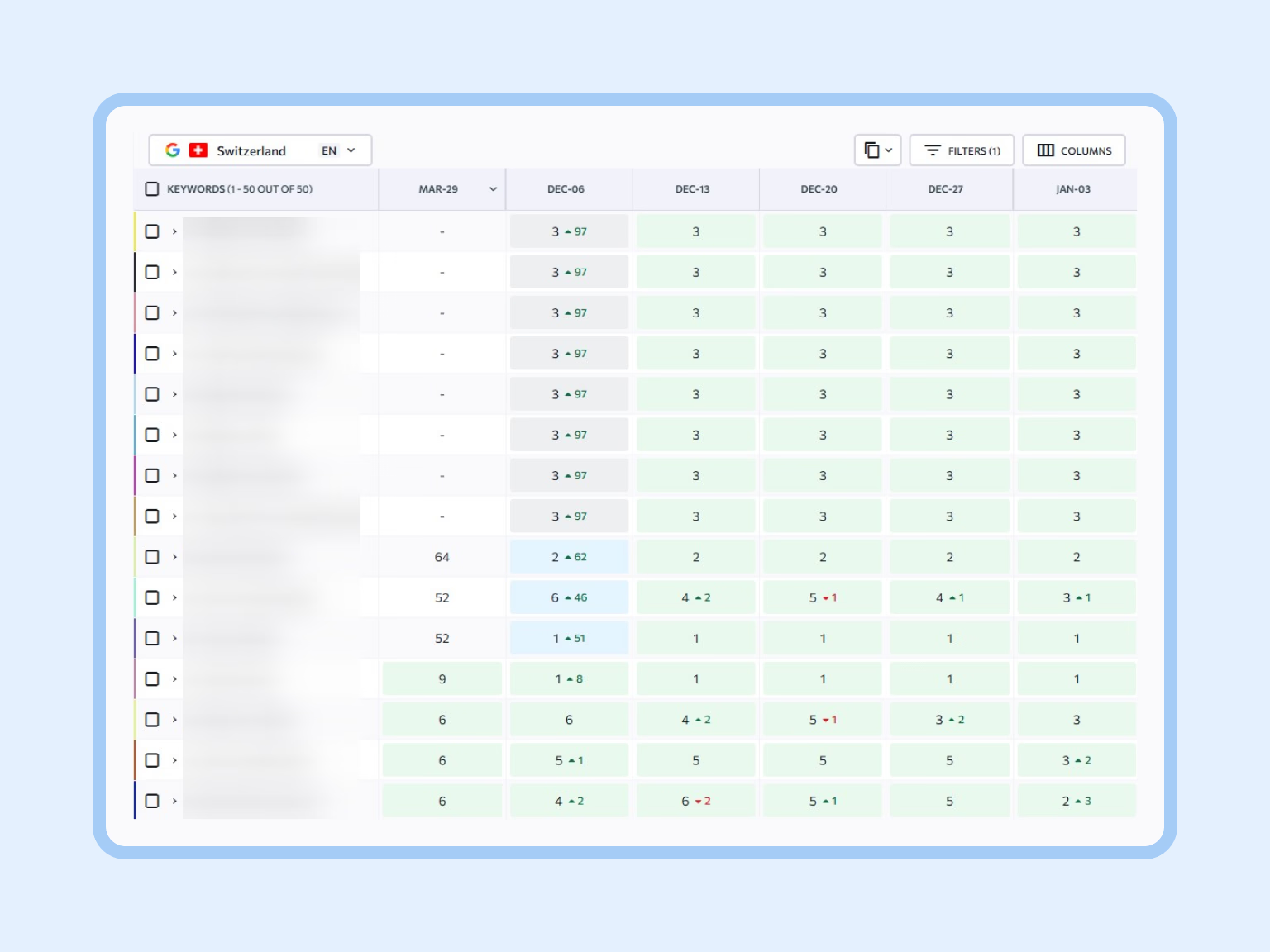
Our results confirm that the strategy we developed after the website audit is both effective and well-executed. But this is just the beginning. With upcoming structural updates and ongoing optimization efforts, our team anticipates even greater success in the months ahead.
Grow stronger with smart SEO
In sharing this case study, we’ve highlighted how well-structured SEO techniques, backed by continuous optimization and data-driven decisions, can lead to substantial growth. SEO is an evolving process, and staying ahead requires adaptability and a strategic approach. And if you’re looking to achieve higher results for your website too, why wait? Get in touch with us today, and let’s discuss how we can develop tailored SEO methods that drive real growth!
in your mind?
Let’s communicate.











